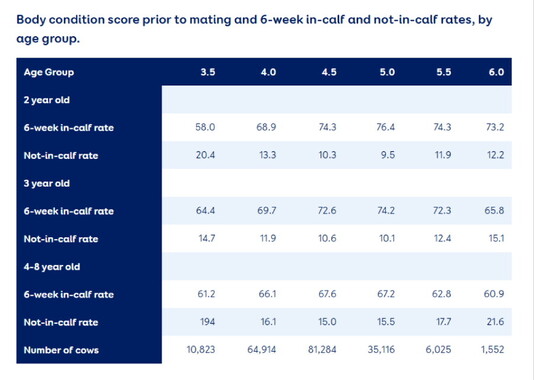The body condition of your cows is always something to keep an eye on, especially after calving, ahead of mating.
A lot of cows were in great condition pre-calving this year, what we'd consider body condition score (BCS) 5.
A loss of one BCS – down to BSC 4 – is expected in the first 7-8 weeks after calving, as the cow adjusts to producing milk and is ‘milked off their back’, while their appetite increases. After this time, cows start to gain body condition again.
Remember though, any cows with BCS 5.5 or higher are more at risk of subclinical and clinical ketosis after calving, so don't let them get too well conditioned over winter.
Ideally, your herd should be increasing in BCS during the three weeks prior to mating for optimal reproductive outcomes. To do this, make sure their diet is nutritionally balanced and of high enough quality and quantity, ensuring each cow can eat enough to meet or exceed her nutritional demands.
With the wet weather we’ve had recently, the wastage of feed also needs to be taken into account. Silage fed out on pasture, and pasture itself, may get trampled into mud easily – wasting lots. In-shed feeding systems may help. If feeding out in trailers, inadequate access for all cows may lead to younger and less dominant cows missing out. Separating them into another mob to feed better, or milking once a day, could be options to help improve these cows' body condition pre-mating.
Looking at the graph below, we can see it’s beneficial to have cows with a BCS of no less than 4.0 and younger cows (2 and 3 year olds) with a BCS of 4.5 when examined two weeks pre-mating, for a better six week in calf rate.
The length of time taken to start cycling is also impacted by BCS and a positive energy balance, affecting non-cycling rates and calving spread.
How can the length of time cows lose condition after calving be minimised?
Check the pasture quality and quantity you are offering, and keep an eye on post-grazing residuals.
Calculate cows’ energy requirements and make up for any lack of pasture with high-quality supplements.
Feed high-quality carbohydrates (maize, meal, etc) to help balance high protein and low carbohydrate levels in spring grass. Remember, these need to be introduced and increased slowly to allow the rumen bacteria to change.
Compare your 10-day average milk fat percentage to last year's average around the same period. An increase in the milk fat percentage can mean your cows are losing weight faster. The genetic make-up of your herd will affect the milk fat percentage too, so comparison with your neighbour is not recommended!
How can we help?
We can come out to your farm and fairly and accurately score the body condition of either your entire herd or a smaller mob of about 70 cows two weeks before mating. We can also do this at other critical times of the year, such as ahead of calving, at end of mating, and around dry-off.
This information can help guide management decisions going into mating – whether for the whole mob or for smaller groups that need to be looked after separately to achieve specific outcomes.
We can also review last year’s reproductive data with you to identify any groups of cows that had poorer outcomes and to help develop a plan for them ahead of the upcoming mating season.
On another note, if you’ve had cows with a BSC over 5.5 at calving and are concerned they may be losing weight too quickly or not milking as well as expected, subclinical or clinical ketosis could be a factor. We can blood test 10 at-risk cows to identify any issues, helping you manage them more effectively and improve their reproductive outcomes.
Body condition and hitting target scores is a key piece of the puzzle when it comes to achieving great mating results. If you’d like support with this, give us a call.


